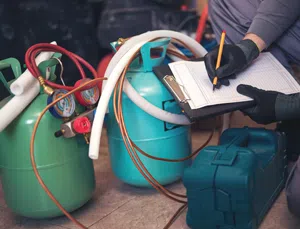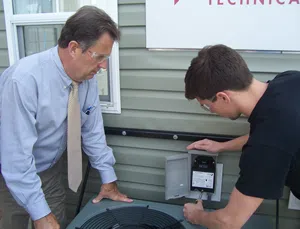New regulations impacting the way refrigerants are handled and sold went into effect on January 1, 2017. Additional regulatory changes will be phased in over the next two years.
The net result is a revised Section 608 EPA Certification Exam to be released in mid- 2017; moreover, the changes to leak rates and inspections will create more business opportunities for HVACR contractors.
The United States Environmental Protection Agency (EPA) has been working over the last several years to revise the Section 608 Refrigerant Management Program to better-reflect today’s industry. Additionally, the EPA is the process of finalizing their revisions to modernize the Section 608 Certification Exam.
For nearly a quarter of a century, the Section 608 Refrigerant Management Program and required certification have been the blueprint for HVACR contractor compliance.
Over the years, a great deal has changed in the HVACR industry leaving the current regulations and exams reflective of a 1993 industry rather than that of 2017.
Modernization
In March of 2015, David Donaldson announced the EPA’s plan to modernize the program during the HVAC Excellence National HVACR Educators and Trainers Conference. He had anticipated that his presentation would draw some criticism from contractors, wholesalers, and instructors. He was however pleasantly surprised to be greeted with mostly friendly comments, including “It’s about time!”
While the deadline for certification has come and gone, contractors are always hiring new personnel that need to become certified. When this next generation of HVACR service technicians take the required Section 608 Certification Exam, they often question the proctor as many of the questions are antiquated or require memorization of dates from before they were born.
A great deal has changed since the signing of the Montreal Protocol of 1987, and the passing of the Clean Air Act of 1990. When Section 608 Refrigerant Management program was launched, it was to address problems created over the years by Ozone Depleting Substances (ODS).
When the HVACR industry transitioned from R-22 to R-410A, it transitioned from an ozone depleting refrigerant to one that had a higher Global Warming Potential (GWP). As technologies used in the HVACR industry change, so must the regulations and exam to be reflective of today’s concerns.
Effective January 1, 2017, the sales restriction requiring CFC and HCFC reclaimed refrigerants may not be resold unless they have been reclaimed by a certified re-claimer has been extended to include HFC and HFO refrigerants.
Effective January 1, 2018, the sales restriction requiring CFC and HCFC virgin refrigerants be restricted to technicians certified under EPA Sections 608 and 609, will extend to virgin HFC and HFO refrigerants.
The result of this action is technicians who install, maintain, service, repair or dispose of appliance that contain HFC and HFO refrigerants must become certified. Those who are already certified under Section 608 do not need to be re-certified. However, those who do not currently hold a Section 608 card will need one by January 1, 2018 to purchase or work with HFC and HFO refrigerants.
It should be noted that the EPA will continue to allow the sale of small cans that contain two pounds or less of refrigerants intended for use in Motor Vehicle Air Conditioning “MVAC” systems and equipped with a self-sealing valve. However, this exception is limited to Do-It-Your-Selfers “DIY-ers” who perform work without monetary compensation.
Documentation
Wholesalers and others who re-sell refrigerants must maintain invoices that indicate: purchaser name, sale date, and the quantity of CFC, HCFC, HFC and HFO refrigerants purchased. These records must be maintained for no less than three years. It should be noted that the EPA is allowing the continued sale of exempt substitutes (Natural Refrigerants).
Employers must require proof of certification for technicians and must maintain a copy of their certification at their place of business for three years after a certified individual leaves the employer.
The EPA has developed new certification exam questions reflecting the new rules. ESCO Institute will be pilot testing these for the EPA during the first quarter of 2017. Upon final review of the pilot test results, the EPA will release the new certification exam questions to other approved certification organizations.
When the new exam is available, all registered proctors will be notified. Until such notification, registered proctors should continue to use the current exam.
HVACR contractors and wholesalers should note that the EPA is requiring new wording on the new certification cards, which will result in new and replacement certification cards having a new look.
The new wording includes: “[Name of person] has successfully passed a [Type I, Type II, Type III, and/or Universal, as appropriate] exam on how to responsibly handle refrigerants as required by EPA’s National Recycling and Emission Reduction Program.”
New recordkeeping requirements for appliances containing 5 to 50 pounds of refrigerant become effective. Technicians must keep records of; the location, date of recovery, and type of refrigerant recovered for each disposed appliance, the quantity of refrigerant by type recovered from disposed appliances in each calendar month.
In addition, the quantity of refrigerant, and type, transferred for reclamation or destruction, the person to whom it was transferred, and the date of the transfer.
All requirements for the maintenance, service, repair and disposal of CFC and HCFC are extended to HFC and HFO refrigerants.
Leak Rate
Effective January 1, 2019, Section 608 regulations include new leak inspection and verification test requirements for owners/operators.
Leak inspections are required for appliances that have exceeded the applicable leak rate, per the schedule below. All visible and accessible components of an appliance must be inspected, using a method or methods that are appropriate for that appliance.
Comfort Cooling with a charge of 50 or more pounds must have a leak inspection once per calendar year until the owner/operator can demonstrate through the leak rate calculations that the leak rate has not exceeded 10 percent for one year.
Commercial Refrigeration and Industrial Process Refrigeration (IPR) with a charge of 50 to 500 pounds must have a leak inspection once per calendar year until the owner / operator can demonstrate through the leak rate calculations that the leak rate has not exceeded 20 percent commercial refrigeration or 30 percent IPR for one year.
Commercial Refrigeration and IPR with a charge of over 500 pounds must have a leak inspection conducted once every three months until the owner/operator can demonstrate through leak rate calculations that the leak rate has not exceeded 20 percent for commercial refrigeration or 30 percent IPR for four quarters in a row.
A quick review of these new requirements should be great news for any HVACR contractor, as it will inevitably lead to more business.





